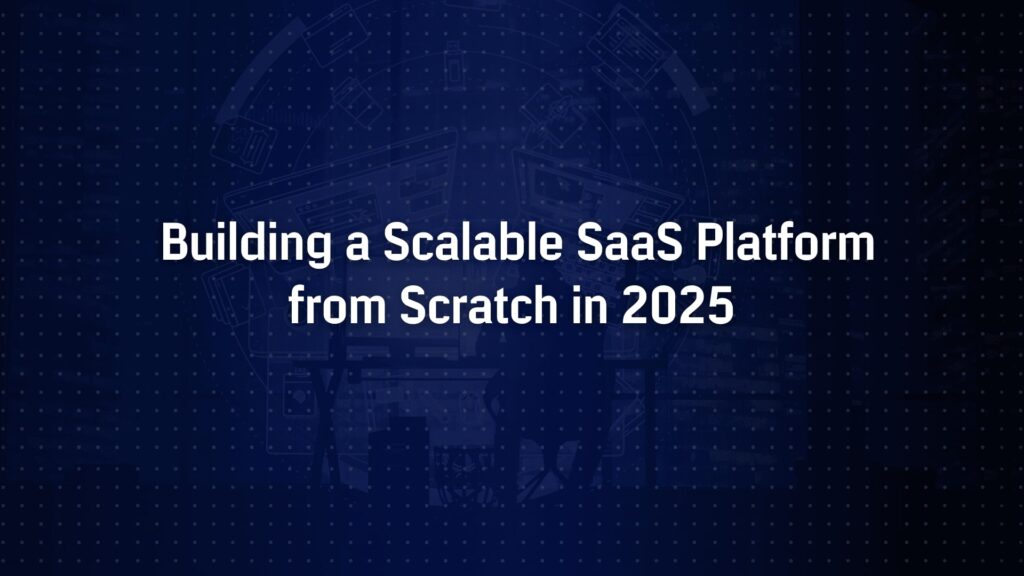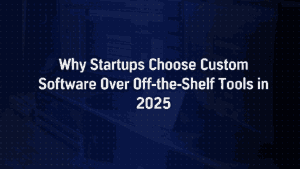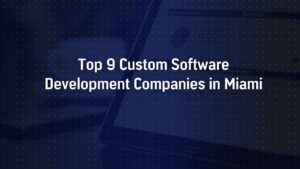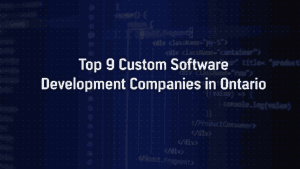How to Build a Scalable SaaS Platform from Scratch in 2025
Building a SaaS startup that can grow fast without buckling under load requires careful planning, technology choices, and execution. Begin by defining a lean MVP that validates your core value proposition. Focus only on the must-have features. Empyreal Infotech’s experience shows that successful SaaS founders “define the problem [the app] solves, and focus only on must-have features. Avoid feature creep.” Gather real user feedback before adding bells and whistles: use landing pages, mockups, or simple prototypes to verify demand. This lean approach lets you learn fast, build momentum, and attract early customers and investors with minimal risk. Once the MVP is proven, Empyreal advises mapping out the entire system on paper before coding. Their process “creates the system architecture design, covering how the front-end and back-end communicate (APIs, microservices), what databases will be used and how data will flow, third-party integrations, and the infrastructure (cloud services, CI/CD pipelines, and so on).” In other words, treat software design like building architecture; make a blueprint first.
1. Validate the MVP and Define Core Value
-
- Identify the core “Aha” feature. Focus on the single most important problem your app solves. Empyreal’s teams use a strict MoSCoW prioritization (Must/Should/Could/Won’t) so that only the essential features ship in the first release. Any feature that is not absolutely required gets parked for later
-
- Lean validation. Test assumptions early: build a basic mockup or landing page, run ads, or pitch to your target customers. Track sign-ups or clicks to ensure people care. (About 42% of products fail due to a lack of market need, so validate demand first.)
-
- Iterate quickly. Use tools like Figma or simple no-code builders to prototype the UI. Show prototypes to users, refine flows, and fix confusion before a single line of backend code is written. This ensures you build the right thing and prevents wasted work.
Taking this MVP-first approach (build fast and learn) not only saves time and money; it also lays the foundation for scaling up later. With a validated scope, you can move confidently into system design.
2. Architect for Scale: Monolith vs. Microservices, Single- vs. Multi-Tenancy
Figure: Single-tenant vs. multi-tenant SaaS architectures. In single-tenant, each customer has its own isolated instance. In a multi-tenant, customers share the same app and infrastructure (data is logically separated).
-
- Multi-tenant vs. single-tenant. Decide how you will isolate customers. In single-tenant, each customer runs on its own app instance and database (complete isolation). This gives maximal control and security but is costly to maintain as you grow. In a multi-tenant, a single application and database serve all customers (data is partitioned by customer). This is more efficient and cost-effective at scale. Fast-growing SaaS typically go multi-tenant (like Salesforce, Netflix, etc.), but watch out for “noisy neighbor” issues: one tenant’s heavy load can slow everyone else. Empyreal’s advice is to plan tenant isolation and monitoring up front so you can throttle or isolate usage per customer when needed.
-
- Monolith first, microservices later. Start simply. Empyreal recommends beginning with a single deployable (monolith) for the MVP, since it is fastest to launch. You can then split into microservices as demand grows. Microservices allow independent scaling of components, but they add complexity. Experts warn that many startups “benefit from a monolithic approach” initially and only migrate to microservices after gaining significant customers. In practice, Empyreal’s blueprint is API-first and modular: define clear service boundaries (e.g., user-service, billing-service, notification-service) from the start. This way, you can gradually decompose the monolith into services without re-architecting from scratch.
-
- Cloud-native foundation. Pick a cloud provider (AWS, Azure, or GCP) early. Use managed services (databases, storage, load balancers) so the cloud handles most scaling work. Plan for autoscaling infrastructure: e.g., set up containerized workloads (Docker) orchestrated by Kubernetes or AWS ECS/EKS, so your app can scale pods/containers up or down automatically as traffic changes. Consider using serverless functions (AWS Lambda, Google Cloud Functions) for unpredictable, bursty workloads. In short, design your stack to “grow with your business, not limit it.”
-
- Database strategy. Plan your data tier for heavy growth: use managed SQL databases (Amazon RDS, Cloud SQL) for transactional consistency, and add NoSQL (DynamoDB, Firestore) if you need schema flexibility or massive scale. Employ read-replicas, sharding, and caching (e.g., Redis) from the start. As Provis Technologies notes, monitor queries from day one and architect your database for read/write-heavy workloads early, since databases often become the biggest scaling bottleneck.
Empyreal’s process literally walls up diagrams of the entire system, like an architect drafting a building plan, before development begins. Their clients find that this thorough system design (APIs, data flow, third-party services, CI/CD, etc.) prevents confusion later and makes large-scale development smoother.
3. Choose a Robust, Future-Proof Tech Stack
The right technologies let you move fast now and scale safely later. Your choices should balance developer productivity, community support, and long-term maintainability. Empyreal emphasizes choosing mature, widely-used tools that align with your team’s skills. Key considerations:
-
- Frontend frameworks. Modern SaaS UIs typically use component-based JavaScript frameworks. Top choices are React, Angular, or Vue.js. For example, React.js (with TypeScript) is popular for dynamic dashboards (its virtual DOM and ecosystem help performance). Angular (backed by Google) provides an all-in-one enterprise framework, ideal for complex apps with long-term maintenance. Vue.js is lightweight and easy to pick up, great for startups or MVPs. Consider server-side rendering (Next.js for React, Nuxt.js for Vue) for SEO and performance. In any case, pick one framework and stick with it. Avoid “chasing trends”; use technologies with active communities (React, Node.js, Django, etc.) rather than unproven newcomers.
-
- Backend frameworks and languages. Your backend drives business logic and data processing. Empyreal commonly works with Node.js (Express) and Python (Django/Flask) for SaaS APIs, but Java (Spring Boot), .NET Core, Ruby on Rails, or Go can all be good choices. For example, Node.js is ideal for real-time apps and microservices. Django (Python) accelerates development with built-in security and ORM features. Spring Boot (Java) or ASP.NET Core offer enterprise-grade stability for large-scale systems. Choose a stack your team knows, and ensure it supports RESTful or GraphQL APIs for easy frontend integration. Again, favour proven, well-documented tools to reduce future maintenance costs.
-
- DevOps and automation. Plan your deployment pipelines up front. Use infrastructure-as-code and CI/CD tools so that deploying or rolling back releases is fast and safe. For example, Empyreal recommends containerizing each service (Docker) and orchestrating with Kubernetes or AWS EKS. Use tools like Terraform or AWS CloudFormation to script your cloud infrastructure. Automate builds and tests with CI/CD (GitHub Actions, GitLab CI, Jenkins, etc.) so every commit is validated and deployed to a staging environment automatically. In short, “when every commit is validated, every deployment is automated. Your SaaS platform stays agile, secure, and scalable.”
-
- Monitoring, logging, and analytics. Do not wait to instrument your app. Integrate logging (ELK stack, Splunk) and monitoring (Prometheus + Grafana, Datadog) from day one to track performance and catch issues. Empyreal advises baking monitoring into the CI/CD pipeline so your team “can react immediately before customers even notice” when something goes wrong. Plan for alerting on key metrics (response times, error rates, CPU/RAM usage, etc.).
-
- Security and compliance. Build security from the start. Use proven authentication (OAuth 2.0 / OpenID Connect via Auth0 or Firebase Auth) and encrypt data in transit and at rest. Implement role-based access control early. Regularly run security scans and penetration tests as you add features. Never assume “it is just an MVP”; data breaches at any stage can destroy trust. Treat security as mandatory: for instance, Empyreal’s guides recommend enabling rate limits, input validation, and audit trails as soon as possible.
By carefully selecting a stack that fits your needs and growth plans, and by automating deployments and monitoring, you will make your SaaS ready to handle rapid scale. (Empyreal’s clients use stacks like React/Node/PostgreSQL or Angular/Spring Boot/DynamoDB and consistently avoid rework later because these technologies are battle-tested.)
4. Build Core Features and Integrate Wisely
With the stack chosen, start coding the backbone services. Empyreal stresses an API-first development: design your REST or GraphQL endpoints up-front (using OpenAPI/Swagger), so front-end and back-end teams can work in parallel. Develop the crucial modules early: user authentication, user profile management, and billing/subscription services. As soon as possible, wire up a payments system (Stripe, Braintree) even if you offer a free trial, so you can test the billing flow end-to-end. Likewise, set up the notification system and background job queue early. In short, “certain features are essential even in an MVP. For example, user authentication must work flawlessly. Likewise, implement a payment or billing stub so you are ready for paid pilots.”
Leverage third-party SaaS integrations:
-
- Do not reinvent common functionality. Empyreal’s blueprint explicitly recommends plugging into trusted external services: e.g., Auth0/Firebase Auth for login, Stripe for payments, AWS S3 for file storage, Twilio for SMS, Segment or Google Analytics for analytics, etc. One industry source notes, “using pre-built APIs for authentication, payment processing, or data storage can significantly cut down development time.” This lets you “stand on the shoulders of giants”: offloading security, compliance, and maintenance to experts so your team focuses on the unique parts of your product.
-
- Microservices vs. shared code. As you build features, follow a modular design. Even if you start monolithic, try to keep services decoupled (e.g., one code module or library handles all email notifications). When the time comes to split services, you will already have logical boundaries. Empyreal often breaks functionality into clear service areas (e.g., user-service, payment-service, notification-service) early, so each can be scaled and deployed independently. This also simplifies debugging and testing.
-
- Quality & testing. Maintain high code quality. Write automated unit and integration tests as you go. Enforce code reviews. According to best practices, a CI pipeline that tests every change “allows teams to catch issues at early stages.” This prevents runaway bugs and ensures any new build is stable. By Day 1, have a CI/CD pipeline that runs your test suite and only promotes well-tested code to production.
5. Deploy, Iterate, and Plan for Growth
After development, get your platform into users’ hands quickly and keep iterating. Use continuous deployment to push updates: blue-green or rolling updates on Kubernetes/ECS let you release without downtime. Configure auto-scaling rules (e.g., CPU or request-based) so additional container instances spin up under load. Employ managed databases with autoscaling (Aurora Serverless, DynamoDB autoscaling, etc.) when possible.
As you onboard real customers, continuously monitor performance and costs. For example, track which SQL queries are slow and add indexes; keep an eye on memory leaks; and move heavy background processing to dedicated workers. Gather user analytics to drive product priorities (Empyreal’s clients often integrate analytics from Day 1 to inform future development). Always iterate on user feedback and data: if a feature causes slowdowns, fix it immediately. Continual optimization (“never assume you are done scaling”) is key to handling rapid growth sustainably.
6. Common Pitfalls to Avoid
Even with a great plan, SaaS startups stumble on predictable mistakes. Keep these pitfalls in mind:
-
- Chasing trends over stability. New frameworks and buzzwords emerge constantly. Resist fads. Empyreal (and others) advise choosing tech with long-term support. For instance, prefer established tools like React, Node.js, or Django rather than brand-new frameworks. A stable, well-known stack reduces future surprises.
-
- Over-engineering too early. Building microservices or complex abstractions before you have customers can slow you down. As one expert warns, most startups benefit from a monolith early on: “the advantage of a fast-paced MVP development outweighs any advantages offered by microservices.” Do not re-architect before you know the demands.
-
- Ignoring performance & security: Leaving performance tuning or security off the to-do list until later is risky. Implement critical protections (authentication, encryption, rate-limiting) from day one. Likewise, monitor your app under load early; even simple load tests can reveal bottlenecks.
-
- Skipping CI/CD or testing: Delaying automated tests and deployment pipelines is a trap. Without CI/CD, releasing often leads to errors and downtime. Every commit should be automatically tested and deployable. This saves massive pain when you rapidly add users and features.
-
- Neglecting tenancy issues: If you go multi-tenant, be vigilant about each customer’s impact. Ensure your cloud infrastructure isolates customers (e.g., use separate Kubernetes namespaces or resource quotas) so one “noisy neighbour” tenant cannot hog all CPU or DB connections. Use tenant-level monitoring: you will need insights at the customer level to diagnose problems.
-
- Underestimating scale: Failing to plan for growth is a common error. As Provis notes, always “map out scalability and long-term growth” early. In practice, that means sizing your database for the first 12–18 months of traffic, planning for additional read replicas, and considering message queues or CDNs if load spikes are expected.
By proactively avoiding these mistakes and by following the best practices above, you will give your SaaS platform the best chance to scale smoothly.
Conclusion
Building a scalable SaaS platform is a marathon, not a sprint. Start lean (Empyreal’s blueprint is “build fast to learn fast, while still preparing to scale later”), but always keep an eye on the future. Map out your architecture, pick proven technologies, and automate everything you can. Empyreal Infotech’s experience with fast-growing SaaS startups shows that balancing a lean MVP with thorough engineering pays off: their clients launch quickly and then scale securely by following exactly these steps.
By following this playbook (defining your core value, designing modular architecture, choosing a rock-solid stack, and iterating with automation), founders and CTOs can build a SaaS platform ready to handle thousands (or millions) of users. The key is to plan for growth from day one and avoid common traps. Do that, and your platform will remain stable, performant, and competitive no matter how rapidly you expand.




